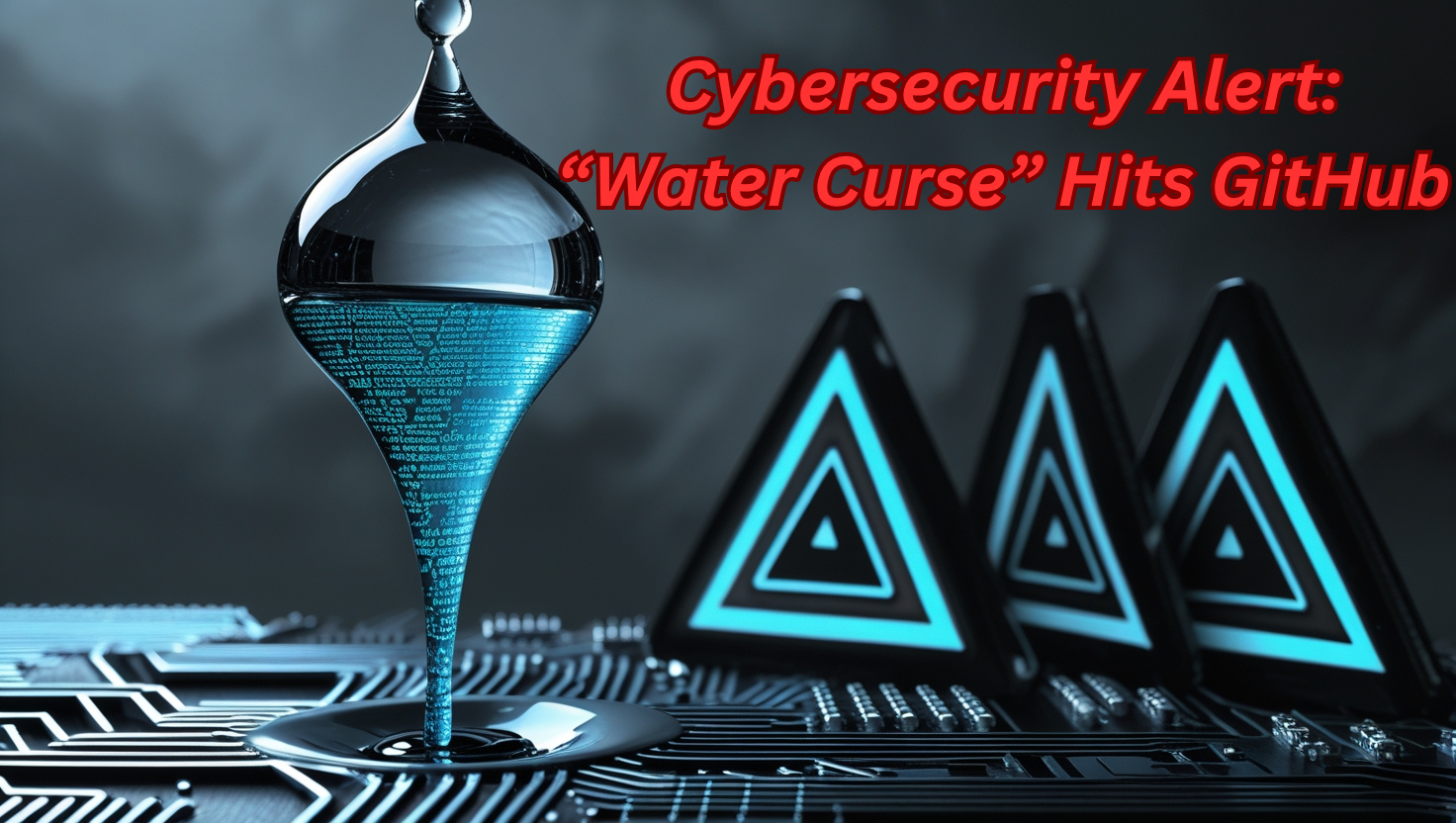You trust GitHub. Not blindly, but enough—especially as a cybersecurity professional who relies on open‑source pen‑testing tools. You’ve starred and cloned your favourite repos, bookmarked them for audits and assessments, and even shared them with colleagues. But now there’s a chilling new threat: “Water Curse.” A supply‑chain poisoning attack hidden inside repos you thought were safe. And it’s targeting people like you—ethical hackers, red‑teamers, cybersecurity analysts—true guardians of cyber defence.
That should send a shiver down your cybersecurity spine. Because if malicious code can sneak into tools you rely on daily, where does that leave your defences? What controls do you really have, and how safe is your cybersecurity toolkit?
These questions hit at the core of why cybersecurity training, continuous learning, and proactive habits aren’t just “nice to have.” They’re essential. In this post, we’ll unpack the “Water Curse” threat, explain how to spot it, share practical steps to protect your systems, and emphasise why strengthening your cybersecurity knowledge—via courses, certifications or self‑study—is vital for guarding against threats like this.
By the end, you’ll walk away with:
- A clear understanding of the Water Curse cybersecurity threat
- Methods to identify if your tools are compromised
- An action plan to protect your supply chain
- A reminder of why ongoing cybersecurity training makes all the difference
What is “Water Curse”?

“Water Curse” is a newly identified supply‑chain attack that inserts malware into trusted pen‑testing tools hosted on GitHub. Instead of targeting end‑users directly, threat actors poison the source—infecting repositories already used by cybersecurity professionals. That makes it especially dangerous. The malicious payload spreads silently when you clone or update a repo, assuming you trust its origin.
This isn’t your average phishing or ransomware attack. It leverages supply‑chain vulnerabilities—specifically the open‑source, community‑driven model that powers cybersecurity innovation. And because the attack isn’t tied to a compromised user, a phishing link, or a cracked executable, it’s stealthier and harder to detect. Many cybersecurity tools rely on regular repo updates, and Water Curse takes advantage of that.
Why Cybersecurity Professionals Are at Greater Risk
This attack was built for people like you—cybersecurity professionals. Here’s why:
- Trusted repositories: Security experts trust vetted GitHub repos. But Water Curse hides in favourite tools, meaning attackers target your trust.
- Frequent updates: Regular pulls or updates mean a single infected release can propagate fast across teams and networks.
- Elevated privileges: OSINT, privilege escalation, and post‑exploitation modules often run with high privileges. If those are poisoned, the fallout is massive.
- Shared environments: You often share tools in pipelines, container images, or team VMs. A single infected module can spread laterally, bypassing many cybersecurity controls.
This is why cybersecurity professionals—usually so vigilant—are uniquely vulnerable. Water Curse preys on your strength: trust in trusted tools.
How the Malware Works

The attack flow looks something like this:
- Repo compromise: Attackers either gain commit access or spoof repository names to push malicious code.
- Hidden payload: The malware is disguised—nested in scripts, embedded in dependencies, or injected via obfuscated installers.
- Trigger mechanisms: It uses stealth triggers such as:
- Post‑install hooks
- Malformed CI/CD pipelines
- Malicious dependency chains
- Exfiltration & persistence: Once active, it may:
- Harvest credentials or secrets
- Install backdoors
- Persist via scheduled tasks
The result? You think you’re just pulling an updated tool—when you’re actually pulling malicious cybersecurity code that undermines your system.
How to Detect If You’re Infected

Fear and doubt can fuel complacency. But as a cybersecurity professional, there are solid steps to find compromise:
- Inspect commit history: Look for unexpected changes or scripts you didn’t author.
- Hash and signature verification: Use GPG‑signed commits, integrity checks, or checksums to validate authenticity.
- Re-run CI pipelines locally: Analyse pre‑ and post‑install behaviour—especially network calls or new processes.
- Diff analysis: Tools like git‑diff or specialized parsers can highlight anomalies.
- Use static and dynamic scanning: Run tools like Trivy, GitHub Code Scanning, or local antivirus in CI to uncover injected payloads.
- Container testing: Rebuild containers from scratch, then scan thoroughly before deployment.
- Endpoint detection: Monitor CPU spikes, network anomalies, and unauthorised file creation on host systems.
By layering these steps you’ll boost your cybersecurity posture—and spot Water Curse infections early.
Immediate Protection Plan
If you suspect exposure—or just want to be secure—take action:
- Freeze updates: Temporarily disable git pull on any suspected repos.
- Isolate environments: Run tools in locked-down containers or VMs before full use.
- Roll back safely: Revert to a known clean commit or tag.
- Audit dependencies: Flag nested submodules and external dependencies for review.
- Revoke credentials: Rotate API keys, tokens, and credentials used in testing environments.
- Report to GitHub: Open an issue and escalate to repo maintainers and security contacts.
- Share widely: Warn teams, peers, clients—especially if they clone or deploy similar repos.
A swift and organised response can minimise damage and protect your cybersecurity integrity.
Long‑Term Defences for Cybersecurity Teams

Think beyond quick fixes. Build long‑term cybersecurity resilience:
A) Strong code integrity controls
- Enforce signed commits and tags
- Use reproducible builds
B) Dependency management
- Use tools like Dependabot for alerts
- Prefer vetted mirrors and registries with trust guarantees
C) Pipeline hardening
- Isolate CI jobs
- Use dedicated build accounts (avoid using your own GitHub keys)
D) Regular training
- Conduct tabletop exercises simulating supply chain attacks like Water Curse
- Keep developers and pen‑testers sharp on cybersecurity hygiene
E) Cybersecurity certifications & courses
Committing to formal cybersecurity education—via self‑paced courses, bootcamps, or modules on platforms like Coursera, Udemy, or SANS—sharpens your awareness. You’ll better spot metadata anomalies in commits, encrypt pipelines correctly, and design stronger defences before threats like Water Curse become crises. Get prepared for international certificate from Digived academy.
Why Cybersecurity Training Matters
In this rapidly evolving threat landscape, cybersecurity isn’t a checkbox—it’s a continuous skill. Water Curse is just the latest example of why building and reinforcing cybersecurity muscle memory matters.
- Training sharpens your eye for anomalies.
- Exposure to real‑world scenarios builds intuition.
- Formal coursework updates you on emerging tactics and best practices.
Some benefits of ongoing cybersecurity education:
- Understanding secure coding practices
- Implementing conformity to frameworks like NIST or MITRE
- Detecting and responding to supply‑chain attacks in real time
Even taking one high‑calibre cybersecurity course per year can help prevent a breach from a compromised repo. if you’re looking forward to learn cybersecurity, Digived is your one stop solution. Unlike many programs focused on theory, Digived emphasises real-world labs from day one—students spend 80% of the time in hands-on work.
also read: Digived Cyber security course in Bengaluru with placement support.
The Bigger Picture: Trust No One, Verify Everything

Water Curse is a stark lesson: the cybersecurity ecosystem depends on trust—but trust must be earned and regularly verified. Attack vectors have multiplied and diversified—what worked last year may leave gaps today.
Key takeaways:
1.Don’t assume open‑source is safe
2.Maintain layered defences and anomaly detection
3.Encourage a cybersecurity culture grounded in scrutiny and verification
Ultimately, your toolbox—and your mindset—are your best allies. Fortify both, and you’ll stay one step ahead.
Your Cybersecurity Action Checklist:
- Audit your cloned repos for suspicious commits
- Rebuild tools in isolated containers
- Enable commit signing and pipeline hardening
- Rotate credentials, tokens, and API keys
- Sign up for a cybersecurity course to stay sharp
- Share this blog with your team to raise awareness
Final Thoughts

Water Curse proves that even the most trusted tools aren’t immune. But by combining vigilance, smart controls, and continuous learning—including cybersecurity certification or training—you can turn this threat into an opportunity. You’ll not only keep your systems and clients safe but also sharpen your skills in an industry that demands relentless growth.
Keep learning. Keep verifying. And stay ahead in the cybersecurity arms race—because in a world where even your toolkit might betray you, knowledge remains your greatest shield.
“Trust is earned. In cybersecurity, it’s also verified—line by line, commit by commit.”
Frequently asked questions (FAQs):
- What is the Water Curse attack?
Water Curse is a cybersecurity threat that hides malware in trusted GitHub pen-testing tools, targeting professionals through supply-chain poisoning. - Who is most at risk from Water Curse?
Cybersecurity professionals, ethical hackers, and red teamers—especially those who regularly use open-source tools from GitHub. - How does the malware spread?
It spreads via cloned or updated GitHub repositories, often using hidden scripts or malicious dependencies. - How can I check if I’m affected?
Audit your GitHub repos, check for suspicious commits, run static scans, and monitor for abnormal system activity. - What can I do to prevent future attacks?
Use signed commits, isolate testing environments, stay updated on threats—and consider taking a cybersecurity course to strengthen your skills.



